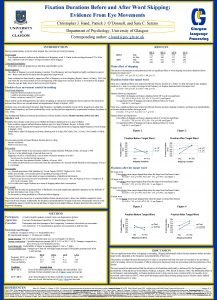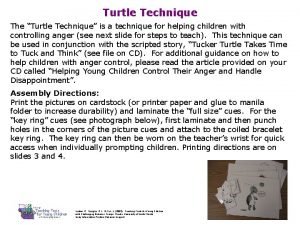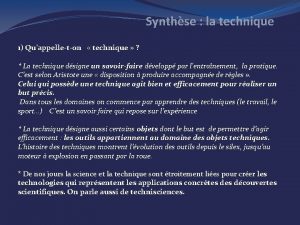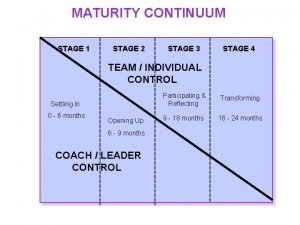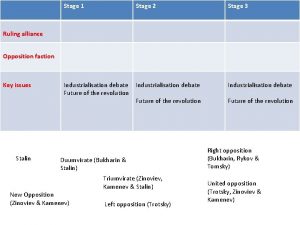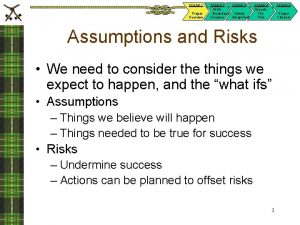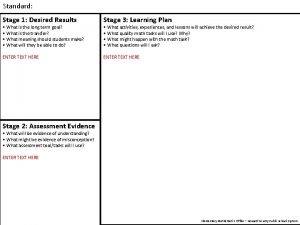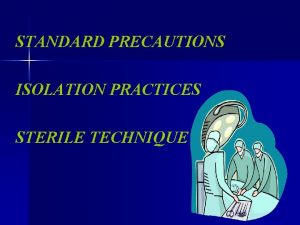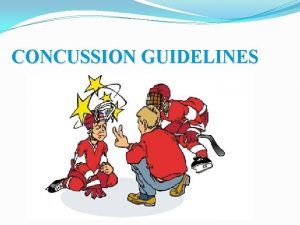The Two Stage Standard Technique Keeps You Out

























- Slides: 25

The Two Stage, Standard Technique Keeps You Out of Trouble & Out of Corners Henry D Clarke MD Professor of Orthopedics Mayo Clinic

Disclosures Henry D Clarke MD Institutional Research Support: Vidacare Stryker Paid Consultant: Confor. MIS Smith & Nephew Zimmer-Biomet Royalties: Confor. MIS Zimmer-Biomet Publishing Income: JAAOS

Deep Peri-Prosthetic Infection Introduction • Infection #1 Reason for revision TKA - 25. 2% of revisions • Aseptic loosening #2 - 16. 1% of revisions Bozic et al, CORR 2010

Deep Peri-Prosthetic Infection Treatment Options • Antibiotic suppression • Arthroscopic debridement • Open debridement with polyethylene exchange - 1 versus 2 stage with abx cement beads • Prosthesis removal & re-implantation - 1 versus 2 stage • Arthrodesis • Amputation • Resection arthroplasty

Deep Peri-Prosthetic Infection Goals for Infected TKA • Make the correct diagnosis - Acute vs chronic - Identify organism • Eradicate infection • Alleviate pain • Preserve a functional limb

Make The Correct Diagnosis Classification Definition Timing Early Post-op 2 – 3 weeks Acute Hematogenous Late, acute previous well functioning joint Late Chronic Months – Years Coventry MB: Ortho Clin North Am 1975

Make The Correct Diagnosis MSIS Criteria Definite Prosthetic Joint Infection Exists where: 1) Sinus tract communicating with joint; or 2) Pathogen isolated from 2 or more separate tissue or fluid samples; or 3) When 3 of the following criteria exist: Workgroup convened by the Musculoskeletal Infection Society, J. Arthroplasty 2014

Make The Correct Diagnosis MSIS Criteria Definite Prosthetic Joint Infection Exists where: i. iii. iv. v. Elevated ESR & CRP Elevated synovial WBC count Elevated synovial PMN % Pathogen in one fluid or tissue culture > 5 WBC/HPF in 5 fields at 400 X mag Workgroup convened by the Musculoskeletal Infection Society, J. Arthroplasty 2014

Make The Correct Diagnosis Additional Tests Improving Accuracy of intra-op cultures: • Careful technique - Clean instrument - Take at least three tissue specimens • Sonification of the extracted implant - Sen 60% tissue vs 75% sonicate-fluid - Sen 45% vs 75% if abx within 14 days Trampuz, New Eng J Med 357, 2007

Make The Correct Diagnosis Additional Tests • Serum Interleukin 6 • Synovial fluid tests - Alpha-defensins (Synovasure) ≈ 100% sensitivity; 95% specificity ≈ 24 -96 hours - Leukocyte esterase dip stick ≈ Inaccurate in presence of bloody aspirate - Joint fluid CRP - WBC gene expression Di Cesare P et al, JBJS 87 -A 2005; Jacovides CL et al, J Arthroplasty 26 (6 Suppl 1), 2011; Deirmengian C et al, CORR 440, 2005; Bingham J et al, CORR 472, 2014

Deep Peri-Prosthetic Infection Chronic PJI • What are the options? - One stage revision - Two stage revision with antibiotic spacer ≈ Static ≈ Articulating

Deep Peri-Prosthetic Infection One Stage Exchange One stage exchange • Becoming more popular in Europe - Especially for infected THA • Advantages - One procedure with less recovery time ≈ Decreased expense - Improved function ? • Disadvantages - Worse results ?

Deep Peri-Prosthetic Infection One Stage Exchange One stage exchange in THA • Austria • 37 patients • 92 % success at mean of 4. 4 5 years follow-up Winkler H, JBJS 90 -B: 1580, 2008

Deep Peri-Prosthetic Infection One Stage Exchange One stage exchange in TKA • Endo Clinic, Germany • 104 patients • 72 % success (76/104 patients) at minimum 5 years follow-up Von Foerster G, Orthopade 20(3), 1991

Deep Peri-Prosthetic Infection One Stage Exchange One stage exchange • French study • 47 patients • 87% survival free of infection at 3 years • Knee function not improved versus historic controls Jenny JY et al, Clin Orthop Rel Res 471: 238, 2013

Deep Peri-Prosthetic Infection Two Stage Exchange One stage versus two stage exchange • 2009 Meta-analysis • 159 patients 1 stage versus 926 2 stage • 73 -100% success 1 stage • 82 -100% success 2 stage “ Two stage revision…remains the Gold Standard” Jamsen E et al, Acta Orthopaedica 80, 2009

Deep Peri-Prosthetic Infection Two Stage Exchange When to consider one stage exchange? • THA>TKA • Known organism • No antibiotic resistance • No sinus tract • No massive bone loss • Adequate soft tissue coverage Gerke T et al, The Infected Hip, JBJS 95 -B: 77, 2013

Deep Peri-Prosthetic Infection Two Stage Exchange Treatment principles • Accurate diagnosis • Identification of organism • Removal of prosthesis, infected tissue, & ALL foreign material • HIGH dose antibiotic cement spacer • 6 weeks appropriate IV antibiotics • Delayed re-implantation with LOW dose antibiotic cement

Deep Peri-Prosthetic Infection Two Stage Exchange High Dose Antibiotic Cement • Per batch Palacos cement - 3. 6 g Tobramycin 3 g Vanco 2 g Cefazolin Less with renal insufficiency or if > 3 packs ≈ 2. 4 g tobra ≈ 2 g vanc ≈ 2 g cefazolin

Deep Peri-Prosthetic Infection Two Stage Exchange Two stage exchange with static cement spacer • 64 Infected TKA - 97% cure for same organism ≈ 2 re-infections - 91% overall cure ≈ 4 re-infection with new organism Goldman & Insall JN et al. : CORR 331, 1996

Deep Peri-Prosthetic Infection Two Stage Exchange Two stage exchange with articulating spacer • 90% infection cure • Facilitate re-implantation • Improves function between stages • Improves ROM & functional outcomes after re-implant Emerson: CORR 404, 2002 Gooding: CORR 469, 2011 Van Thiel CORR, 2011 Fehring: CORR 380, 2000 Meer: JBJS 85 A, 2003

Deep Peri-Prosthetic Infection Two Stage Exchange Two stage exchange • Patient satisfaction and function after septic vs aseptic revision TKA - 54 septic revision - 2 stage with Prostalac 57 aseptic revision Min 2 yr follow-up No difference in WOMAC, Oxford-12, SF 12, patient satisfaction data, and range of motion Meek RM et al, J Arthroplasty, 2004

Deep Peri-Prosthetic Infection Two Stage Exchange What happens when 2 stage revision fails ? • Mayo Series - 45 patients failed 2 stage exchange for infected TKA - Success of repeat 2 stage exchange is dependent on host and extremity grade ≈ 70% uncompromised host (MSIS type A) with acceptable wound (MSIS 1 or 2) ≈ 50% compromised host (MSIS B 2) ≈ 0% severely compromised (MSIS C 3) Hanssen et al; JBJS 99: 19, 2017

How I Manage an Infected TKA Take Home Message • 2 stage revision with high dose antibiotic articulating cement spacer - Gold standard - Chronic infection, especially in TKA • Let Dr Mc. Pherson and others at high volume centers experiment • Do the right thing for your patients, get on base…don’t swing big and miss!

Thank You for Your Attention
 What figurative language is you're my kryptonite
What figurative language is you're my kryptonite Single and two stage tendering
Single and two stage tendering Phase one denial
Phase one denial The word-skipping technique lets you figure out
The word-skipping technique lets you figure out Matthew 11 28 message
Matthew 11 28 message Osha 1910 134
Osha 1910 134 I had breakfast before i went to school
I had breakfast before i went to school You put your left foot in
You put your left foot in What keeps the sun hot
What keeps the sun hot Romeo and juliet famous quotes
Romeo and juliet famous quotes Holds data instructions and information.
Holds data instructions and information. 30 dollar riddle answer
30 dollar riddle answer Peng wang cheese tofu calories
Peng wang cheese tofu calories Shunt voltage regulator factory
Shunt voltage regulator factory To keeps one's temper meaning
To keeps one's temper meaning What does a rebel do when everybody wears a uniform
What does a rebel do when everybody wears a uniform For whoever desires to save his life
For whoever desires to save his life Farmer jim keeps 12 hens in every coop
Farmer jim keeps 12 hens in every coop Moose hatchet
Moose hatchet Chapter 5 natural laws and car control
Chapter 5 natural laws and car control Type 1 or type 2 error statistics
Type 1 or type 2 error statistics Drive right chapter 5
Drive right chapter 5 A new settlement that keeps close ties to its homeland
A new settlement that keeps close ties to its homeland Staging theatre definition
Staging theatre definition Disadvantage of arena stage
Disadvantage of arena stage Stage right stage left
Stage right stage left



